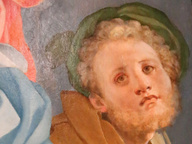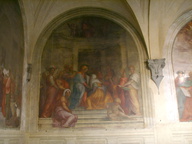The Third Act. Jean-Baptiste Bernadet + Benoit Platéus + John Roebas

© Jean-Baptiste Bernadet
Dal 29 October 2015 al 19 December 2015
Torino
Luogo: Palazzo Saluzzo Paesana / Neochrome
Indirizzo: via della Consolata 1bis / via Bellezia 14
Telefono per informazioni: +39 011.7653067
E-Mail info: info@neochromegallery.com
Sito ufficiale: http://www.neochromegallery.com
29.10.15 - 15.11.15 @ Appartamento Padronale di Palazzo Saluzzo Paesana
19.11.15 - 19.12.15 @ NEOCHROME
NEOCHROME è lieta di presentare The Third Act, una mostra itinerante suddivisa in due parti che si propone di esporre e mettere in dialogo le nuove opere di Jean-Baptiste Bernadet, Benoit Platéus, John Roebas.
Inaugurando nelle sontuose stanze dell'Appartamento Padronale di Palazzo Saluzzo Paesana per poi trasferirsi, successivamente, nella sede attuale di NEOCHROME, The Third Act riunisce gli artisti sulla base della comune propensione che questi nutrono per la tematica del tempo, da intendersi nel suo dispiegamento diacronico da sempre interpretato attraverso il linguaggio dell'arte e della letteratura moderna.
La premessa espositiva dei due “atti” offre l'opportunità di apprezzare la pratica degli artisti in due contesti molto dissimili (nonostante risalgano entrambi al XVIII secolo). Da un lato, l'architettura barocca del rinomato palazzo di Gian Giacomo Plantery, dall'altro, l'estetica essenziale di NEOCHROME, un convento in origine. Tale percorso esalta l'inevitabile progressione della forma, della cultura e delle sedi che ospitano l'arte nel corso della Storia.
Sin dagli esordi, l’opera di Jean-Baptiste Bernadet trova la sua cifra stilistica nelle cromie intense e vivide con cui ha saputo reinterpretare l’astrazione pittorica. Appropriandosi della ridondanza espressiva di alcuni movimenti artistici del XX secolo, dal Simbolismo alla Pittura a Campi di Colore, i dipinti di Bernadet colgono lo scorrere del tempo marcandone la scansione tramite molteplici linee e tonalità, senza tuttavia cedere alla tentazione compositiva. L’artista predilige infatti il sovrapporsi spontaneo ed estremamente dinamico di segni, tracce, livelli di colore.
Tra le opere più iconiche del “primo atto”, Untitled (Fugue - Screen III) (2015) ben esprime il virtuosismo lirico di Bernadet, e stimola lo sguardo dell’osservatore operando un’inedita sintesi narrativa tra attante e scenografia. Esposta nell’Appartamento Padronale di Palazzo Saluzzo Paesana, essa diventa una sorta di “contesto nel contesto”, ove l'impiego della scenotecnica celebra la natura performativa dell'arte e della sua stessa mise-en-scène. Inoltre, l’esecuzione pittorica del gesto iterato mima la struttura sequenziale dei pannelli, lasciando immaginare l’incremento di una vera e propria sineddoche. Il titolo del lavoro naturalmente viene investito di duplice significato, poiché se dapprima viene colto il riferimento alla più importante forma contrappuntistica strumentale, una lettura più approfondita mira a stimolare la riflessione sulla perdita stridente della coscienza di sé; un intervallo allucinatorio, consumato nella tensione drammatica che Bernadet alimenta mascherando le “note” del suo “spartito” interiore in infinite sfumature su tela.
Ad ogni modo non esiste solo il tempo del dramma e dell’improvvisazione, captato nel flusso del presente. Se la serie Fugue sembra appartenere alla dimensione eraclitea del Pánta rêi, occorre riconoscere in Bernadet una recherche altrettanto ossessiva per il passato ed il futuro. Basti pensare ad Untitled (Screen IV) (2015), anch’esso esposto a Palazzo Saluzzo Paesana, protagonista di un dialogo immaginario con gli affreschi di Domenico Guidobono; o ancora, all’immenso tramonto Trails (2015), che apre le danze al “secondo atto” di NEOCHROME. Quest’ultimo, partorito dalla mente di Bernadet come “un’antologia stratificata di tramonti”, appartiene al tempo del domani, a quell’accelerazione quasi sincronica che genera il colore ancor prima della linea, e prefigura l’orizzonte di un nuovo hic et nunc, sospeso tra le madeleine di Proust e la proiezione pittorica verso l’oltre.
I poster vintage rappresentano la matrice della serie Behind The Scenes (2015) di Benoit Platéus. Il materiale, in genere estrapolato da manifesti b-movies appariscenti nel design, viene incollato frontalmente sulla tela, impedendo dunque al contenuto visivo di palesarsi. Quest'ultimo assume una serie di composizioni geometriche elementari, prive di dettagli figurativi, che costituiscono la base del gesto pittorico ritraente l'immagine; decontestualizzata e reinterpretata. L'unione delle componenti incontra l'intervento ad olio di Platéus e rivela il momento di finitudine che deriva dal taglio e dalla pittura tradizionale su tela.
La serie pittorica è accompagnata dal video monumentale Wow (2015). Frammenti di vita urbana ripresi in vari locali, le scene girate mettono in luce lo scarto tra l'immagine e ciò che viene narrato, e il modo in cui la loro interazione reciproca sia capace di determinare il coinvolgimento emotivo nel suo divenire, in particolare per quanto concerne l'immagine in movimento.
John Roebas esplora l’ipotesi concettuale del tempo attraverso la sintesi materica delle sostanze chimiche che abitano il suo universo, come la resina epossidica, di uretano o smalto. Tali elementi testimoniano l'invecchiamento dell'opera, accentuato in chiave scultorea nella serie degli orologi. Elaborando lo sforzo compositivo a partire dalle immagini fotografiche, Roebas si inserisce nel rapporto che intercorre tra il processo e il sedimento dell'intera produzione, indagando la fiducia in un’immediatezza culturale contro una dimensione alternativa, non umana. L'opera si scopre immagine di se medesima e la percezione del tempo che avanza è indicata nella scelta di ogni singola componente, mentre un concetto più ampio e indefinito incombe quasi fotograficamente cristallizzato sotto la superficie. Jean-Baptiste Bernadet è nato nel 1978 a Parigi, vive e lavora a Brussels.
Mostre selezionate: Wiels Contemporary Art Center (Brussels), Valentin (Paris), Almine Rech (Paris), Karma (New York), American Contemporary (New York), Rod Barton (London), Retrospective Gallery (Hudson, NY), Marfa Book Company (Marfa), Venus Over Manhattan (New York), Michael Jon Gallery (Miami), Mon Chéri (Brussels), East Hampton Shed (New York), Maison Particulière (Brussels), Palais des Beaux-Arts (Brussels).
Benoit Platéus è nato nel 1972 a Chênée, vive e lavora a Brussels.
Mostre selezionate: Albert Baronian (Brussels), Galerie Jeanroch Dard (Paris), Michael Thibault Gallery (Los Angeles), Marfa Book Company Gallery (Marfa), Rectangle (Brussels), Galerie Aline Vidal (Paris), Smak (Gent), La Maison Rouge (Paris), Mu.ZEE (Ostend), Isabella Bortolozzi (Berlin), Etablissement d'en face (Brussels), WIELS (Brussels), Jeu de Paume (Paris).
John Roebas è nato nel 1985 a Tegucigalpa, vive e lavora a New York.
Mostre selezionate: Levy Delval (Brussels), Bryce Wolkowitz (New York), Galleri Jacob Bjørn (Aarhus), Galerie Jeanrochdard (Paris), Institute of Contemporary Art (Portland), Centre D'Action Culturelle (Niort).
19.11.15 - 19.12.15 @ NEOCHROME
NEOCHROME è lieta di presentare The Third Act, una mostra itinerante suddivisa in due parti che si propone di esporre e mettere in dialogo le nuove opere di Jean-Baptiste Bernadet, Benoit Platéus, John Roebas.
Inaugurando nelle sontuose stanze dell'Appartamento Padronale di Palazzo Saluzzo Paesana per poi trasferirsi, successivamente, nella sede attuale di NEOCHROME, The Third Act riunisce gli artisti sulla base della comune propensione che questi nutrono per la tematica del tempo, da intendersi nel suo dispiegamento diacronico da sempre interpretato attraverso il linguaggio dell'arte e della letteratura moderna.
La premessa espositiva dei due “atti” offre l'opportunità di apprezzare la pratica degli artisti in due contesti molto dissimili (nonostante risalgano entrambi al XVIII secolo). Da un lato, l'architettura barocca del rinomato palazzo di Gian Giacomo Plantery, dall'altro, l'estetica essenziale di NEOCHROME, un convento in origine. Tale percorso esalta l'inevitabile progressione della forma, della cultura e delle sedi che ospitano l'arte nel corso della Storia.
Sin dagli esordi, l’opera di Jean-Baptiste Bernadet trova la sua cifra stilistica nelle cromie intense e vivide con cui ha saputo reinterpretare l’astrazione pittorica. Appropriandosi della ridondanza espressiva di alcuni movimenti artistici del XX secolo, dal Simbolismo alla Pittura a Campi di Colore, i dipinti di Bernadet colgono lo scorrere del tempo marcandone la scansione tramite molteplici linee e tonalità, senza tuttavia cedere alla tentazione compositiva. L’artista predilige infatti il sovrapporsi spontaneo ed estremamente dinamico di segni, tracce, livelli di colore.
Tra le opere più iconiche del “primo atto”, Untitled (Fugue - Screen III) (2015) ben esprime il virtuosismo lirico di Bernadet, e stimola lo sguardo dell’osservatore operando un’inedita sintesi narrativa tra attante e scenografia. Esposta nell’Appartamento Padronale di Palazzo Saluzzo Paesana, essa diventa una sorta di “contesto nel contesto”, ove l'impiego della scenotecnica celebra la natura performativa dell'arte e della sua stessa mise-en-scène. Inoltre, l’esecuzione pittorica del gesto iterato mima la struttura sequenziale dei pannelli, lasciando immaginare l’incremento di una vera e propria sineddoche. Il titolo del lavoro naturalmente viene investito di duplice significato, poiché se dapprima viene colto il riferimento alla più importante forma contrappuntistica strumentale, una lettura più approfondita mira a stimolare la riflessione sulla perdita stridente della coscienza di sé; un intervallo allucinatorio, consumato nella tensione drammatica che Bernadet alimenta mascherando le “note” del suo “spartito” interiore in infinite sfumature su tela.
Ad ogni modo non esiste solo il tempo del dramma e dell’improvvisazione, captato nel flusso del presente. Se la serie Fugue sembra appartenere alla dimensione eraclitea del Pánta rêi, occorre riconoscere in Bernadet una recherche altrettanto ossessiva per il passato ed il futuro. Basti pensare ad Untitled (Screen IV) (2015), anch’esso esposto a Palazzo Saluzzo Paesana, protagonista di un dialogo immaginario con gli affreschi di Domenico Guidobono; o ancora, all’immenso tramonto Trails (2015), che apre le danze al “secondo atto” di NEOCHROME. Quest’ultimo, partorito dalla mente di Bernadet come “un’antologia stratificata di tramonti”, appartiene al tempo del domani, a quell’accelerazione quasi sincronica che genera il colore ancor prima della linea, e prefigura l’orizzonte di un nuovo hic et nunc, sospeso tra le madeleine di Proust e la proiezione pittorica verso l’oltre.
I poster vintage rappresentano la matrice della serie Behind The Scenes (2015) di Benoit Platéus. Il materiale, in genere estrapolato da manifesti b-movies appariscenti nel design, viene incollato frontalmente sulla tela, impedendo dunque al contenuto visivo di palesarsi. Quest'ultimo assume una serie di composizioni geometriche elementari, prive di dettagli figurativi, che costituiscono la base del gesto pittorico ritraente l'immagine; decontestualizzata e reinterpretata. L'unione delle componenti incontra l'intervento ad olio di Platéus e rivela il momento di finitudine che deriva dal taglio e dalla pittura tradizionale su tela.
La serie pittorica è accompagnata dal video monumentale Wow (2015). Frammenti di vita urbana ripresi in vari locali, le scene girate mettono in luce lo scarto tra l'immagine e ciò che viene narrato, e il modo in cui la loro interazione reciproca sia capace di determinare il coinvolgimento emotivo nel suo divenire, in particolare per quanto concerne l'immagine in movimento.
John Roebas esplora l’ipotesi concettuale del tempo attraverso la sintesi materica delle sostanze chimiche che abitano il suo universo, come la resina epossidica, di uretano o smalto. Tali elementi testimoniano l'invecchiamento dell'opera, accentuato in chiave scultorea nella serie degli orologi. Elaborando lo sforzo compositivo a partire dalle immagini fotografiche, Roebas si inserisce nel rapporto che intercorre tra il processo e il sedimento dell'intera produzione, indagando la fiducia in un’immediatezza culturale contro una dimensione alternativa, non umana. L'opera si scopre immagine di se medesima e la percezione del tempo che avanza è indicata nella scelta di ogni singola componente, mentre un concetto più ampio e indefinito incombe quasi fotograficamente cristallizzato sotto la superficie. Jean-Baptiste Bernadet è nato nel 1978 a Parigi, vive e lavora a Brussels.
Mostre selezionate: Wiels Contemporary Art Center (Brussels), Valentin (Paris), Almine Rech (Paris), Karma (New York), American Contemporary (New York), Rod Barton (London), Retrospective Gallery (Hudson, NY), Marfa Book Company (Marfa), Venus Over Manhattan (New York), Michael Jon Gallery (Miami), Mon Chéri (Brussels), East Hampton Shed (New York), Maison Particulière (Brussels), Palais des Beaux-Arts (Brussels).
Benoit Platéus è nato nel 1972 a Chênée, vive e lavora a Brussels.
Mostre selezionate: Albert Baronian (Brussels), Galerie Jeanroch Dard (Paris), Michael Thibault Gallery (Los Angeles), Marfa Book Company Gallery (Marfa), Rectangle (Brussels), Galerie Aline Vidal (Paris), Smak (Gent), La Maison Rouge (Paris), Mu.ZEE (Ostend), Isabella Bortolozzi (Berlin), Etablissement d'en face (Brussels), WIELS (Brussels), Jeu de Paume (Paris).
John Roebas è nato nel 1985 a Tegucigalpa, vive e lavora a New York.
Mostre selezionate: Levy Delval (Brussels), Bryce Wolkowitz (New York), Galleri Jacob Bjørn (Aarhus), Galerie Jeanrochdard (Paris), Institute of Contemporary Art (Portland), Centre D'Action Culturelle (Niort).
SCARICA IL COMUNICATO IN PDF
COMMENTI

-
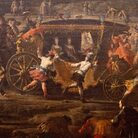 Dal 20 December 2025 al 20 April 2026
Caserta | Reggia di Caserta
Dal 20 December 2025 al 20 April 2026
Caserta | Reggia di Caserta
Regine: trame di cultura e diplomazia tra Napoli e l’Europa
-
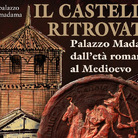 Dal 19 December 2025 al 23 March 2026
Torino | Palazzo Madama - Museo Civico d’Arte Antica
Dal 19 December 2025 al 23 March 2026
Torino | Palazzo Madama - Museo Civico d’Arte Antica
Il castello ritrovato. Palazzo Madama dall’età romana al medioevo
-
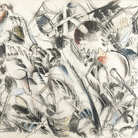 Dal 17 December 2025 al 19 January 2026
Roma | Palazzo della Cancelleria
Dal 17 December 2025 al 19 January 2026
Roma | Palazzo della Cancelleria
De Humana Mensura di Linda Karshan
-
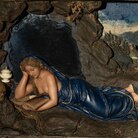 Dal 18 December 2025 al 12 April 2026
Firenze | Gallerie degli Uffizi
Dal 18 December 2025 al 12 April 2026
Firenze | Gallerie degli Uffizi
Cera una volta. Sculture dalle collezioni medicee
-
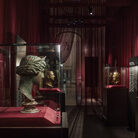 Dal 11 December 2025 al 9 April 2026
Firenze | Museo Archeologico Nazionale di Firenze
Dal 11 December 2025 al 9 April 2026
Firenze | Museo Archeologico Nazionale di Firenze
Icone di Potere e Bellezza
-
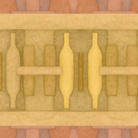 Dal 11 December 2025 al 11 January 2026
Roma | Palazzo Esposizioni Roma
Dal 11 December 2025 al 11 January 2026
Roma | Palazzo Esposizioni Roma
Giorgio Morandi nella Collezione Eni. Un viaggio attraverso la storia culturale del cane a sei zampe e l’eredità di Enrico Mattei
